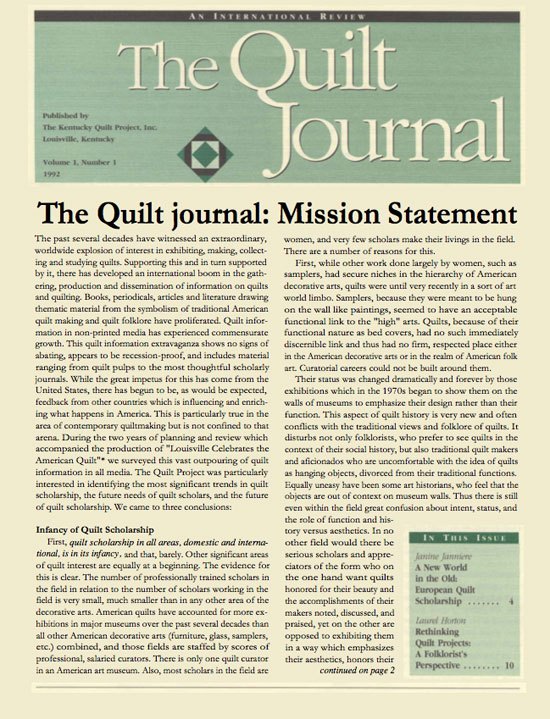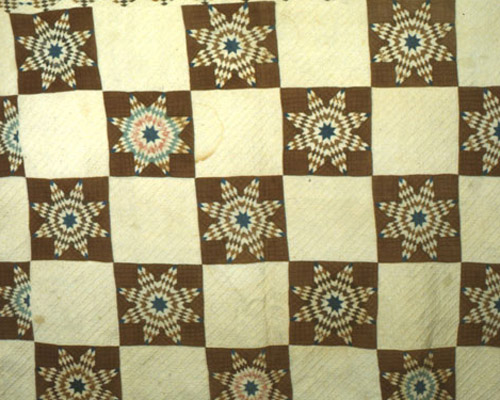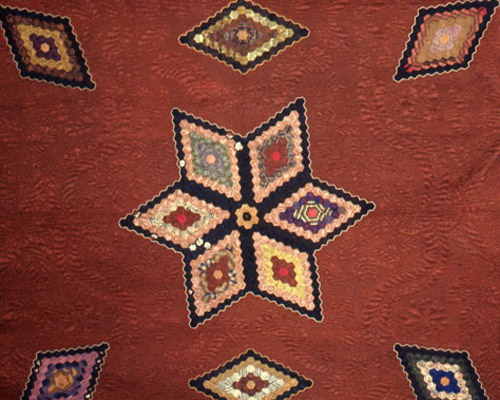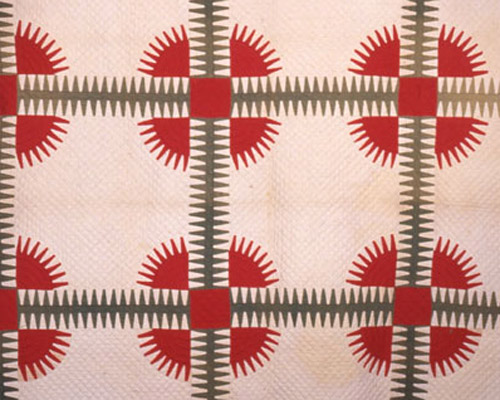BACK TO DOCUMENTATION PROJECTS
Kentucky Quilt Project
The Kentucky Quilt Project was formed in 1981 to survey the state’s quilts. Its original directors were Shelly Zegart, Eleanor Bingham Miller, and Eunice Ray. Katy Christopherson organized the volunteers who aided that survey. It collected data for permanent reference on more than 1,000 quilts and exhibited some of the most interesting found in “Kentucky Quilts 1800-1900,” which appeared first at the Louisville Museum of History and Science in 1983 and at 12 other museums thereafter under the auspices of the Smithsonian Institution Traveling Exhibition Service. Since 1981 groups in 48 states have undertaken quilt surveys informed by the methods and directions of The Kentucky Quilt Project. Other Project activities in the nineteen eighties included securing a Virginia Ivey quilt for Kentucky, bringing “The Artist and the Quilt” exhibition to Louisville, curating an exhibition of Kentucky quilts in Australia, and giving financial assistance to Kentucky quilt groups for special projects. It also acted as consultant for other state quilt surveys. Quilts documented during this phase of KQP are included in the Index. Louisville Celebrates the American Quilt
In 1990 the current Directors of The Kentucky Quilt Project, Shelly Zegart, Eleanor Bingham Miller and Jonathan Holstein, began to discuss an appropriate way to celebrate the 20th anniversary of the historic exhibition, “Abstract Design in American Quilts,” which opened at the Whitney Museum of American Art, New York, in 1971. The exhibition, curated by Jonathan Holstein and Gail van der Hoof, created a worldwide awareness of American quilts as designed objects. The result was “Louisville Celebrates the American Quilt.” The celebration began in November, 1991, and continued through March, 1992. We decided a group of events which might illustrate and further the extraordinary developments in the field over the past two decades would be most beneficial. A recreation of the Whitney exhibition was a logical starting point, as many quilt researchers and scholars, quilt makers, collectors, and museum personnel now actively involved with quilts, never saw that original show. We planned also five other exhibitions, four conferences and additional associated events. Exhibitions in Kentucky
Some quilts exhibited during this phase of KQP are included in the Quilt Index, although many of the actual quilts have since been moved or been gifted by the owners to organizations. The exhibitions were:
Abstract Design in American Quilts at the Louisville Museum of History and Science
A Plain Aesthetic: Lancaster Amish Quilts at the J. B. Speed Art Museum
Quilts from these two exhibitions and owned by Jonathan Holstein have been donated to the International Quilt Museum.
Always There: The African-American Presence in American Quilts at the Louisville Museum of History and Science
Quilts Now at Zephyr Gallery
Narrations: The Quilts of Yvonne Wells and Carolyn Mazloomi at the Louisville Visual Art Association (Water Tower)
Quilt Conceptions: Quilt Designs in Other Media at the Kentucky Art and Craft Gallery.
Conferences
The four conferences were designed to further quilt scholarship in specific areas.
The African-American and the American Quilt looked at African-American quilts both in relation to the African textile tradition and as part of the mainstream of American quiltmaking.
Directions in Quilt Scholarship surveyed the field past and present, discussed quilts as art historical and social objects, and looked at problems in the field.
Quilts and Collections: Public, Private and Corporate discussed the ways quilts are seen, collected and used by individual and corporate collectors, and museums.
Toward an International Quilt Bibliography, through the individual efforts and interactions of 15 scholars, suggested the form and directions for a potential new quilt bibliography. Other events included lectures by scholars and quilt artists, and opportunities for participants to discuss issues in the field. In addition, data and dialogues developed at the conferences will be published, and audio and visual documentation of significant events were made for permanent record.
The Directors of The Kentucky Quilt Project hoped the Celebration would bring, as did Abstract Design in American Quilts and The Kentucky Quilt Project’s survey, new perspectives and directions to quilt scholarship, understanding and appreciation.*
*Adapted from “The Kentucky Quilt Project, Inc, Directors’ Statement – 1991-1992,” Shelly Zegart, Eleanor Bingham Miller, and Jonathan Holstein in Kentucky Quilts 1800-1900 (Louisville, KY: The Kentucky Quilt Project, Inc.) 1992.
The Quilt Journal - An International Review
View Journals
Mission Statement

The Quilt Journal, Volume 2, Number 1 1993
This is a shortened version of the Mission Statement which appeared in our first issue. For some readers this second issue will be their introduction to the Journal, and we felt a statement of its basic purpose and goals should be included. First-time readers are advised a full Mission Statement is to be found in Volume 1, Number 1, 1992.
– Editors’ Note
Background
Scholars from a number of disciplines gathered in Louisville, Kentucky, in February 1992 for Louisville Celebrates the American Quilt, produced under the auspices of The Kentucky Quilt Project, Inc. The Celebration's exhibitions, seminars and other events were planned to illustrate and further the worldwide growth of interest in quilts and quilting which has developed over the past several decades and provide a wider forum for emerging quilt scholarship. During the two years of planning and review, directors Jonathan Holstein, Eleanor Bingham Miller and Shelly Zegart surveyed the vast outpouring of quilt information in all media. The directors were particularly interested in identifying the most significant trends in quilt scholarship, the future needs of quilt scholars, and the future of quilt scholarship. They reached three conclusions:
Infancy of Quilt Scholarship
First, quilt scholarship in all areas, domestic and international, is in its infancy. We are at the beginning of a new quilt era in we will witness worldwide development in all areas of quilt interest and activity. As a consequence, an unprecedented exists for documenting and studying the field as it grows and develops.
Interdisciplinary Involvement
A second conclusion which grew from our study of current quilt scholarship and our experiences at the Celebration was that the future of quilt study is interdisciplinary. No other decorative art object carries the quantity or quality of significant social and aesthetic information to be found in quilts. Embodied in the objects are data of the greatest interest to art and social historians, feminist scholars, students of industry and economics, folklorists, etc. Increasingly quilt scholarship will draw on other disciplines for insights and information. More scholars from other areas will be studying quilts. Methodologies of quilt study will change.
International Focus
The final conclusion was that in all areas of quilt activity, there will be increasing international participation. It is one of the Journal's missions to facilitate the work of those around the world who will be coming to quilt research from other fields other places and with different visions. The need for a source of quilt information directed toward other fields and other countries as well as to the American quilt establishment, toward the future, is clear.
Mission and Objectives
The Journal will filter from the enormous flow of quilt information produced in the United States and abroad, things of interest to other disciplines and to quilt professionals and amateurs in this and other countries. To accomplish the Journal's mission the editors intend to:
Search diligently for and publish interesting and provocative articles and reviews related to the field which might not elsewhere be printed;
Offer a forum to quilt scholars with unusual and interesting ideas;
Draw attention to exhibitions, articles and ideas which the editors feel are significant but might be overlooked;
Discuss controversial ideas which generally are not being aired;
Invite all interested scholars to submit articles and article ideas.
The Quilt Journal will also examine critically where it is appropriate publications, conferences and exhibitions of interest to the field. We wish to welcome all of you to The Quilt Journal: An International Review and look forward to communicating important quilt information to you in coming years.
Copyright 1993
University of Louisville Archives and Records Center
Founded in 1973, the University Archives and Records Center is one of seven research libraries at the University of Louisville. With collections totaling approximately 13,000 linear feet, the Archives serves the research needs of faculty, staff, and students, as well as scholars from other institutions and the local community. As “The Memory of the University,” the Archives preserves and makes available for research the permanent records of the University (one of the oldest municipal universities in the United States), its predecessor schools, and the schools it has absorbed.
Besides caring for the records of the university, the Archives collects and preserves primary source material of local interest. The Urban History Collection contains records of nineteenth- and twentieth-century local businesses, cultural organizations, social service agencies, and churches, along with the personal papers of important political figures, business leaders, and scholars. The Archives is also home to the Women’s History Collection, currently numbering over sixty collections that document the lives and careers of Louisville women and local women’s organizations.
The Archives holds the records of The Kentucky Quilt Project, one of the first organizations to stimulate the collection of information about and promote interest in the craft of quilting on a local, national, and international basis. As a participant in the Quilt Index project, the Archives will process the documentation of a subset of the approximately 1,300 quilts recorded by the The Kentucky Quilt Project and digitize both the data and images for inclusion in the Index.
Project description provided by the Kentucky Quilt Project, Inc.
View all records in this project
-
Ephemera
Documenting Kentucky's Quilts: an Expe...
Christopherson, Katy
-
Ephemera
The Quilt Journal - An International R...
Holstein, Jonathan; Miller, Eleanor Bingham; Zegart, Shelly
-
Ephemera
The Quilt Journal - An International R...
Holstein, Jonathan; Miller, Eleanor Bingham, Zegart, Shelly
-
Ephemera
The Quilt Journal - An International R...
Holstein, Jonathan; Miller, Eleanor Bingham; Zegart, Shelly
-
Ephemera
The Quilt Journal - An International R...
Holstein, Jonathan; Miller, Eleanor Bingham; Zegart, Shelly
-
Ephemera
The Quilt Journal - An International R...
Holstein, Jonathan; Miller, Eleanor Bingham; Zegart, Shelly
-
Ephemera
The Quilt Journal - An International R...
Holstein, Jonathan; Miller, Eleanor Bingham; Zegart, Shelly


